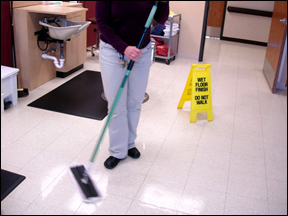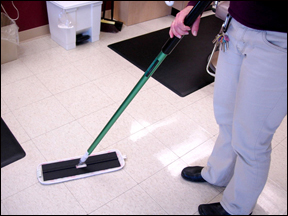Best practices -- Alternative mopping system
Health care industry
Alternative mopping system reduces ergonomic risk factors
Housekeeping employees in a long-term care facility have seen the benefits of a new mopping system that reduces the ergonomic risk factors typically associated with use of a conventional string-mop system. A microfiber mopping system was provided as an alternative floor-cleaning system. This system has reduced the stresses to the back, hands, arms, shoulders and lower extremities.
A microfiber mop weights five pounds less than conventional mops, reducing the physical effort required to clean floor surfaces. The microfiber system cleans more effectively with a lesser amount of cleaning solutions, reducing the overall effort needed to clean a floor surface and the time required for the floor to dry, minimizing slip hazards.
The handle of the mop holds 15 ounces of cleaning solution and can be refilled anywhere in the facility where there is a dispensing system or a jug of solution can be carried on a housekeeping cart. This has eliminated the need to pull a mop bucket along, while also pushing a cleaning cart, reducing the stresses on the back.
The microfiber mop fits easily on the cleaning cart for easy transport, minimizing the force requirements and awkward postures normally associated with pulling a conventional string mop and bucket.
The system has also eliminated the need to empty the large, heavy buckets of contaminated cleaning solution associated with string-mop systems and has eliminated the continual lifting of heavy mop heads into and out of the cleaning bucket. The system has also eliminated the need for bending down and wringing out of mop heads.
Use of the new system has helped prevent further reports of injury and muscle strain previously associated with mopping tasks.
|
A new microfiber mopping system is lightweight and easy to use to effectively clean floor surfaces. |
|
Disclaimer: Photographs of commercially available products posted on this site are for reference purposes only and do not imply any endorsement by the Minnesota Department of Labor and Industry. The best-practices ideas have been reviewed and posted solely at the discretion of the department and should only be considered as possible examples for reducing risk factors, based on existing ergonomics guidelines. Employers and employees need to work together to identify and control ergonomics risk-factors within the workplace to better ensure changes made to a work process will be effective in reducing risk-factors and maintaining work efficiency.


